In 2022, research teams from our hospital made significant breakthroughs and progresses in multiple research fields, and published high-quality and high-level articles in internationally-renowned journals, such as Nature, PNAS and Blood, etc.
1. The team from Department of Hepatobiliary Surgery publishes a review article on methane production and biological effects in Nature
On March 9, 2022, the latest research results of the team led by Professor Frank Keppler from Heidelberg University in Germany were published in Nature, revealing a process of methane production, driven by non-enzymatic reactive oxygen species (ROS), in all living organisms, and this mechanism is only associated with ROS, iron and methyl donors. Zhang Jingyao, an associate research fellow from Professor Liu Chang'steam, was invited by Nature to participate in the whole publishing process of this article.
Subsequently, Professor Liu Chang's team was invited by Nature to contribute an article entitled “Methane might be made by all living organisms” regarding the mechanism of methane production in all living organisms, which was published in News & Views of Nature on March 9, 2022. Based on the research results of Professor Frank Keppler's team, the team proposed several ideas. First, methane released by organisms is an indirect marker of ROS level in the organism, and it can reflect the oxidative stress level of the organism by detecting methane level in breath, blood or tissue samples, which has certain prospect in the field of in vitro diagnostics. Second, the process of ROS-driven methane production is an endogenous protective mechanism of the body against antioxidant stress. Third, exogenous intake of methane (inhaling methane gas, drinking methane-rich water,etc.) can play an auxiliary therapeutic role by lowering oxidative stress level and inflammatory reaction, which has certain value in clinical application and health industry. In this article, the team, for the first time, proposed the biological effect of endogenous and exogenous methane and predict the development direction in the field of biomedicine.
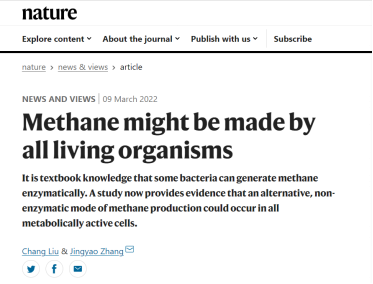
2.The team of Biobank discovers and names PEIP, and unravels the antibacterial mechanism
On July 5, 2022, the team led by Professor Liu Bing and Professor Wang Yawen published an article entitled “Bacteriophage protein PEIP is a potent Bacillus subtilis enolase inhibitor” in Cell Reports. For the first time, the team discovered the bacteriophage enolase inhibitor protein of bacterial glycolysis pathway and named it as PEIP, and elucidated the broad-spectrum antibacterial effect of PEIP and unravel the exact molecular mechanism. Besides, they proposed that PEIP can partially inhibit the glycolysis pathway of human tumor cells because it is highly conserved in all organisms.
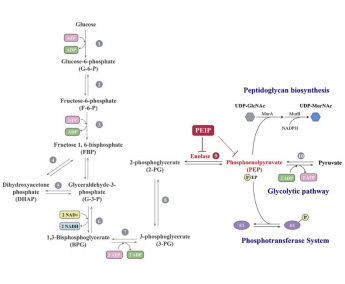
3.The team of Biobank makes significant progress in the field of antibacterial and antimalarial strategies
On February 22, 2022, the team led by Professor Liu Bing and Professor Wang Yawen published an online article entitled "Bacteriophage protein GP46 is a cross-species inhibitor of nucleoid-associated HU proteins" in PNAS. The team explicitly elucidated the exact mechanism of bacteriophage protein Gp46 inhibiting bacteria by binding to bacterial histone, becoming the first worldwide to identify the antibacterial gene of phage-encoded bacterial histone-like HU protein. The expression of Gp46 can elongate the cell body of bacterial strain, make the nucleus-like region disappear, and finally lead to bacterial death, which is a new category of broad-spectrum antibacterial protein.

4.The team of Department of Cardiology publishes a cover article revealing the mechanism of vascular inflammation inBlood
On July 21, 2022, Professor Yuan Zuyi and Professor Wang Shengpeng from his team cooperated with the team of Fellow Stefan Offermanns from Max-Planck-Gesellschaft in Germany published a cover article entitled "Mechanosensation by endothelial PIEZO1 is required for leukocyte diapedesis" in Blood, which reported that white blood cells are interfered by the shear stress of blood flow during the process of passing blood vessels, leading to the increase of membrane tension of vascular endothelial cells. This mechanical force can be sensed by Piezo1 ion channel, inducing the increase of intracellular calcium, thus activating endothelial cells and causing the contraction of endothelial cells and the opening of barriers, and finally inducing white blood cells to complete the transfer. This study innovatively reveals the key mechanical mechanism of vascular inflammatory reaction from the biomechanical perspective.
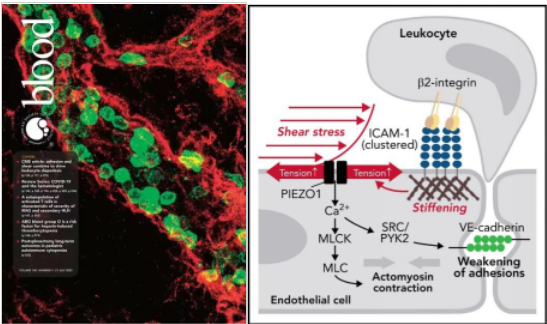
5.The team from Department of Cardiology makes significant progress in the field of obesity and albuminuria
In June, 2022, the team of Professor Mou Jianjun cooperated with the team led by Lu Yao, an invited research fellow from the Third Xiangya Hospital of Central South University, and published the latest original research results in an Article entitled "Early life body mass index trajectories and albuminuria in midlife: a 30-year prospective cohort study" in eClinical Medicine. In this study, group-based trajectory modeling (GBTM) was used to identify the BMI trajectories over 30 years since 1987 based on "Hanzhong Adolescent Hypertension Study Cohort", representing the weight changes in Chinese population over 30 years since China's reform and opening up. In this study, BMI trajectories tend to gradually increase from childhood, adolescence, adulthood to middle age, and are significantly associated with higher uACR and an increased risk of albuminuria later in life, offering potential strategies for early prevention and treatment of cardiovascular and renal diseases.

6. The team from Department of Cardiology makes significant achievement in the field of blood pressure variability and subclinical kidney damage
In April, 2022, Professor Mou Jianjun's team published an online article entitled "Associations of long-term visit-to-visit blood pressure variability with subclinical kidney damage and albuminuria in adulthood: a 30-year prospective cohort study” in Hypertension, which showcased significant outcomes in the field of blood pressure variability and subclinical kidney damage. The team, for the first time, comprehensively analyzed the relationship between long-term blood pressure variability, subclinical renal damage and albuminuria in adulthood. The findings suggested that from childhood to adulthood, the greater the blood pressure variability, the higher the risk of subclinical renal damage and albuminuria, prompting that early identification of long-term blood pressure variability contributes to predicting the long-term risk of renal and cardiovascular diseases, which is of significance to deeply understand the association between hypertension and CKD and explore early prevention and control strategies.
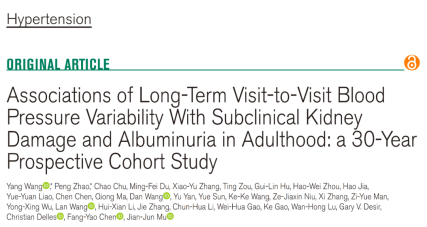
7. The team from Department of General Surgery obtains groundbreaking achievement in engineering medicine treatment of IBD
On January 28, 2022, Professor She Junjun from Department of General Surgery, Professor Kam W. Leong, Fellow of National Academy of Medicine and National Academy of Engineering, and Shao Dan, Research Fellow from South China University of Technology jointly published an article entitled “A nanoparticulate dual scavenger for targeted therapy of inflammatory bowel disease” in Science Advances. The research teams collectively developed a biodegradable nanomedicine that acts against IBD by scavenging cell-free DNA (cfDNA) and reactive oxygen species (ROS). This drug-free nanoparticulate dual scavenger can significantly down-regulate the levels of cfDNA and ROS in intestinal tissues and peritoneal lavage fluid, which yields high clinical efficacy and biological safety for various inflammatory bowel disease models by comprehensively regulating inflammatory response and oxidative stress. Besides, this nanomaterial has highly efficient targeting and retention effects upon the inflammatory tissues, can achieve better therapeutic effect with lower administration frequency and higher biological safety. The biodegradable nanoparticles are simple to prepare and convenient to apply, and can further serve as a vector to carry related drugs to realize synergistic and efficient comprehensive treatment of IBD, which has promising prospect for clinical translation.

8. The team of Department of Gastroenterology makes significant progress in rapid healing of ESD-induced gastric ulcer
In August, 2022, the team led by He Shuixiang cooperated with Professor Cai Kaiyong’s team from Bioengineering College of Chongqing University to publish an article entitled “Biocompatible, adhesive and stable GelMAc/PVAMA/MPDA@Cur hydrogels regulate immune response to improve endoscopic submucosal dissection-induced gastric ulcer healing in vivo” in Applied Materials Today. They successfully designed a GelMAc/PVAMA hydrogel coated with curcumin polydopamine nanoparticles based on the special physiological environment of gastrointestinal tract and pathological microenvironment characteristics of wounds after ESD. In vitro and in vivo experiments in this study proved that this hydrogel system can exert anti-inflammatory and anti-ROS effect and promote ulcer healing by regulating the polarization of macrophage M1/M2, which has promising application potential.
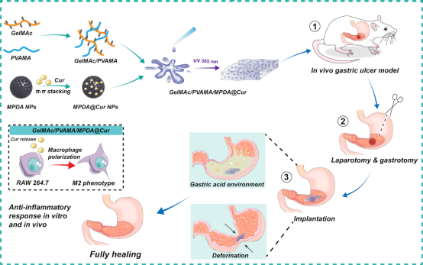
9. The team of Department of General Surgery achieves progress in postoperative abdominal adhesion
In January, 2022, the latest research results of Li Xuqi's team were online published as an Article entitled “A combination of hybrid polydopamine-human keratinocyte growth factor nanoparticles and sodium hyaluronate for the efficient prevention of postoperative abdominal adhesion formation” in the first issue of Acta Biomaterialia.
Li Xuqi's team cooperated with Professor Liu Ruilin, a pharmaceutical expert from Xuzhou Medical University to attempt to prepare mussel protein-inspired biomimetic self-assembled nanoparticles for coating with keratinocyte growth factor (KGF). When KGF was loaded with sodium Ha gel, the prevention effect of postoperative abdominal adhesion could be significantly improved. The hybrid gels remain in a semi-fluid state in vivo, allowing them to be distributed throughout the abdominal cavity with changes in position and avoid direct contact between the injured peritoneal surfaces. The hybrid gels have the ability of pH- and enzyme-responsive "semi-intelligent" controlled release of KGF. The microenvironment inflammatory response and hypoxia after peritoneal injury can reduce the extracellular pH, and stimulate the sustained and smooth release of KGF, thus continuously promoting the orderly regeneration and repair of the injured peritoneal mesothelial cell layer. This method yields promising application prospect in preventing postoperative abdominal adhesion.
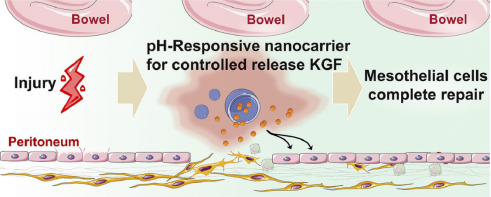
10. Multiple research teams participate significant studies and publish articles in The Lancet, Nature and Cell, etc.
Recently, a large-scale cluster randomized controlled study of "China Rural Hypertension Control Project (CRHCP)" jointly completed by Professor Sun Yingxian from the First Hospital of China Medical University and Professor Mou Jianjun from Department of Cardiology of our hospital has created a major breakthrough. On April 30, 2022, the primary outcome of the first stage CRHCP entitled "A village doctor-led multifaceted intervention for blood pressure control in rural China: an open, cluster randomised trial" was published online in The Lancet. Professor Mou Jianjun was the second author, and our hospital was the second affiliation of this article.
On April 8, 2022, multiple prestigious research institutes at home and abroad, including Psychiatric Genomics Consortium (PGC), Broad Institute, and the team led by Professor Zhu Feng and Ma Xiancang from our hospital, joined hands to complete the largest schizophrenia genomic research. Relevant findings were published in an Article entitled "Mapping genomic loci implicates genes and synaptic biology in schizophrenia" in Nature.
On May 26, 2022, researchers in Department of Urology and Department of Neurosurgery participated in neoPPI research andpublished an online article entitled "Systematic discovery of mutation-directed neo-protein-protein interactions in cancer" in Cell. Tang Cong, a doctoral student of Professor He Dalin from Department of Urology and Alafate Wahafu, a doctoral student of Professor Wang Maode from Department of Neurosurgery are the co-authors of this article.
On July 15, 2022, research results of multi-center rectal cancer NOSES big-data study led by Professor Wang Xishan from Cancer Hospital of Chinese Academy of Sciences and participated by Professor Sun Xuejunfrom Departmentof General Surgery were publishedas an article entitled“Short-term and oncological outcomes of natural orifice specimen extraction surgery (NOSES) for colorectal cancer in China: a national database study of 5055 patients”in Science Bulletin. In this 4-yearstudy, NOSES data of 5055 Chinese patients with colorectal cancer were analyzed. The findings in this study indicate that NOSES yields highshort-term efficacy and oncological outcomes, which confirms its safety and feasibility, and providesevidence for its application in the treatment of colorectal cancer.